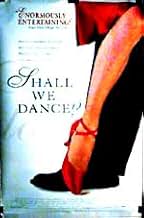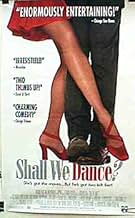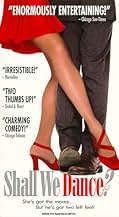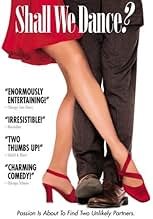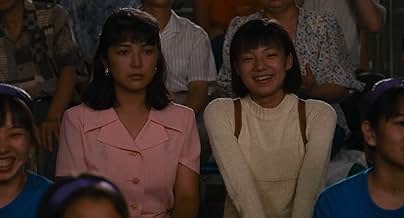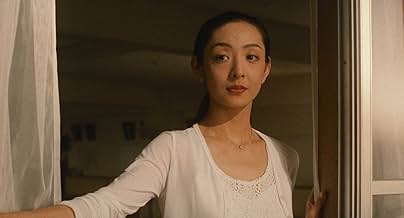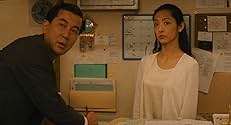VALUTAZIONE IMDb
7,7/10
12.175
LA TUA VALUTAZIONE
Aggiungi una trama nella tua linguaA successful but unhappy Japanese accountant finds the missing passion in his life when he begins to secretly take ballroom dance lessons.A successful but unhappy Japanese accountant finds the missing passion in his life when he begins to secretly take ballroom dance lessons.A successful but unhappy Japanese accountant finds the missing passion in his life when he begins to secretly take ballroom dance lessons.
- Regia
- Sceneggiatura
- Star
- Premi
- 55 vittorie e 7 candidature totali
Eri Watanabe
- Toyoko Takahashi
- (as Eriko Watanabe)
Reiko Kusamura
- Tamako Tamura
- (as Raiko Kusamura)
Recensioni in evidenza
A good movie with an outstanding story. Many assume that the movie is a love story from the typical Hollywood style: boy meets girl love affair. This is not. It is a story of a man who forgot to love life. His everyday life has become routine and he has no idea where his life is taking him. He has a house and car payment and a family of 3 that he has to provide for. From home, he takes his bicycle to the train and then he takes the train to work. Everyday, same old, same old. Then, one day he sees something that turns his world up-side-down. Dancing? A new way to express himself, a way to communicate with others and show his true colors. The passion he finds is not in a woman or mere lust, but in living life to the fullest. He begins to stop and look around him as he uses dancing to live. A terrific cast of funny and heart filled characters. This is not a movie about Japan or the Japanese, although it does take place in Japan and the cast is made up of Japanese. The setting and the plot of this movie is timeless.
Watched this last night and was bowled over by the heartfelt story line, the excellent character development, and the good karmic vibe emanating from the acting and movie as a whole.
Without giving away too much of the plot, it begins with an ordinary joe who commutes to his office job every day who becomes inspired to take dance lessons. Along the way the protagonist and the assorted characters he meets in his quest to be smooth on the dance floor learn lessons about others and about themselves.
The story has a prologue about what dancing in Japan symbolizes sociologically, so it isn't exactly as simple to learn to dance in Japan as it is here in the U.S.
The film is lighthearted; you'll laugh out loud at some of the sight gags. Yet it is also dignified in a way hard to describe. All of the film's characters are taken seriously, as they are, and none are diminished because of their "imperfections."
I've been thinking about taking social dance classes with some friends. It just so happened a friend lent me the video on learning to dance. Is this synchronous or what? I think so because now I'm really geeked to give it a try.
Watch this wonderful family film (small children might not get it, but teens certainly would) and smile at the genuine caring you see shown in it time and again.
Why they would make a remake of Shall We Dance is a mystery, as it is perfect as-is.
Without giving away too much of the plot, it begins with an ordinary joe who commutes to his office job every day who becomes inspired to take dance lessons. Along the way the protagonist and the assorted characters he meets in his quest to be smooth on the dance floor learn lessons about others and about themselves.
The story has a prologue about what dancing in Japan symbolizes sociologically, so it isn't exactly as simple to learn to dance in Japan as it is here in the U.S.
The film is lighthearted; you'll laugh out loud at some of the sight gags. Yet it is also dignified in a way hard to describe. All of the film's characters are taken seriously, as they are, and none are diminished because of their "imperfections."
I've been thinking about taking social dance classes with some friends. It just so happened a friend lent me the video on learning to dance. Is this synchronous or what? I think so because now I'm really geeked to give it a try.
Watch this wonderful family film (small children might not get it, but teens certainly would) and smile at the genuine caring you see shown in it time and again.
Why they would make a remake of Shall We Dance is a mystery, as it is perfect as-is.
A middle-aged accountant in an established, successful Japanese firm has a house, a wife, and a beautiful daughter. He works hard all day, comes home, goes to sleep, and then does the whole thing over again. He's a man who's lost his soul. He's an automaton, a cog in the larger Japanese industrial society. As old Karl Marx would have put it, he's alienated from the larger society of his fellow workers, his family, and from himself. What a predicament.
On the way home from work, he spots a beautiful but melancholy woman looking out the window of a dance studio. Every night, she's there, calling to him like a siren or one of the fabled wood nymphs. There's a sexual attraction that fuels his interest. But there's also much more: he immediately identifies with her, feels an instant sense of connection, because she is outwardly expressing his inner angst. So he takes the leap, overcomes his fear, and signs up for dance lessons.
In the West, this commonplace occurrence would go unnoticed: we would say that Mr. Sugiyama is having a `mid-life crisis.' We would expect him to have an affair with his secretary, or suddenly buy leathers and a Harley and hit the road. But in Japan, where Ballroom dancing is viewed as lascivious, perhaps even perverted behavior, this makes for a much more interesting dilemma. The main character, Mr. Sugiyama, a respectable accountant, is drawn into dance by the alluring siren. He acts on his impulse to get to know her. But then, when reality sets in that he will never win her affection, he falls in love with dance. It becomes his personal means both of self-discovery, and self-expression. It's a fascinating transformation.
One of the reasons that this movie works so well is its rich and varied set of characters, all of which are simply adorable. This is an incredibly impressive Japanese film. It's a must-see video.
On the way home from work, he spots a beautiful but melancholy woman looking out the window of a dance studio. Every night, she's there, calling to him like a siren or one of the fabled wood nymphs. There's a sexual attraction that fuels his interest. But there's also much more: he immediately identifies with her, feels an instant sense of connection, because she is outwardly expressing his inner angst. So he takes the leap, overcomes his fear, and signs up for dance lessons.
In the West, this commonplace occurrence would go unnoticed: we would say that Mr. Sugiyama is having a `mid-life crisis.' We would expect him to have an affair with his secretary, or suddenly buy leathers and a Harley and hit the road. But in Japan, where Ballroom dancing is viewed as lascivious, perhaps even perverted behavior, this makes for a much more interesting dilemma. The main character, Mr. Sugiyama, a respectable accountant, is drawn into dance by the alluring siren. He acts on his impulse to get to know her. But then, when reality sets in that he will never win her affection, he falls in love with dance. It becomes his personal means both of self-discovery, and self-expression. It's a fascinating transformation.
One of the reasons that this movie works so well is its rich and varied set of characters, all of which are simply adorable. This is an incredibly impressive Japanese film. It's a must-see video.
This movie opened in Korea four years later than in Japan due to the now-defunct ban on Japanese pop culture in Korea. But the audiences in Korea were just as enthralled and enchanted by the story as the rest of the world was.
Like Japan, there are many salarymen in Korea who are also facing a mid-life crisis. After the movie premiered in Seoul, dance studios were reporting up to a 50-percent increase in the number of new students.
I took two years of jazz dance during college, and have seen Strictly Ballroom and Dance With Me. But this movie was the driving force behind me finally signing up for ballroom dance (called dancesport in Korea) lessons.
Mr. Aoki was hilarious as the employee who led a double life unbeknownst to his colleagues. It was also interesting to find out the reasons why the other students took lessons.
I too would have taken classes just to get close to the sexy dance instructor alone.
This movie is a perfect ten in my book.
Like Japan, there are many salarymen in Korea who are also facing a mid-life crisis. After the movie premiered in Seoul, dance studios were reporting up to a 50-percent increase in the number of new students.
I took two years of jazz dance during college, and have seen Strictly Ballroom and Dance With Me. But this movie was the driving force behind me finally signing up for ballroom dance (called dancesport in Korea) lessons.
Mr. Aoki was hilarious as the employee who led a double life unbeknownst to his colleagues. It was also interesting to find out the reasons why the other students took lessons.
I too would have taken classes just to get close to the sexy dance instructor alone.
This movie is a perfect ten in my book.
Shohei Sugiyama is a dispirited salaryman who has lost his lust for life. Despite having a wife and daughter, a nice house and a steady job, depression grips him. One day, while riding the train home, he spots a beautiful, forlorn looking woman-Mai Kishikawa- gazing out the window of a dance studio. Although not really interested in dance, Sugiyama plucks up enough courage to take lessons in the studio, in order to get to know her. Under the tuition of the elderly Tamako Tamura, however, he begins to fall in love with dancing, finding meaning in his life once more.
Written and directed by Masayuki Suô, 'Shall We Dance?' is a heartwarming comic-drama that works on multiple levels. Funny and sad both, it can be viewed as a critique of rigid, conformist Japanese society, which is contrasted with the expressive, liberating Western dance practiced in the studio. It also shows how one's life can become better and more meaningful by following a dream or goal, and how purpose can be restored by doing so. Conversely, it also illustrates how communication and honesty are vital for relationships to prosper, shown through the clashes and confusions between Sugiyama and his wife Masako, as well as those between Mai and her old dance partner.
Above all else, it is a love letter to ballroom dancing, and those that practice it. Sugiyama's stale existence is given colour and excitement after he joins the studio. Not only does he have something to live for, but he begins meeting people who genuinely affect him. Whether it is his mentor Tamura, or his friend Tomio Aoki, everyone he meets while dancing brings something to his life, not least of which is Mai, who- perhaps inadvertently- teaches him to love again. Suô's screenplay is full of depth, as well as great, witty dialogue, and is compelling and captivating.
Naoki Kayano's cinematography is stylish and evocative, contributing to the mood of the piece. He captures the dance sequences with verve, heightening the emotion with his tracking shots and snappy zooms. He contrasts the dull, dour tones of Sugiyama's office and home with the bright, colourful hues of the dance studio and the ballroom competitions, reflecting the different worlds that Sugiyama inhabits. Lush and memorable, Kayano's work complements the graceful and energetic movements of the dancers, creating a remarkable visual spectacle.
Moreover, the expertly choreographed dancing is incredible to behold. The film makes ballroom dancing- when learnt properly- look like the most beautiful expression of emotion on earth. The soundtrack is stirring, making excellent use of songs by the likes of Rogers and Hammerstein, while Yoshikazu Suo's original score complements the narrative astutely. Furthermore, Kyôko Heya's production design- in conjunction with Kayano's visuals- is full of contrast and realism, bolstering the film's impact.
Koji Yakusho stars as Sugiyama, opposite Tamiyo Kusakari as Mai, Reiko Kusamura as Tamura and Naoto Takenaka as Aoi. Yakusho, as always, makes the character compelling and complex, bringing much humour to the role. We empathise with Sugiyama, and are on his side the whole way through. Kusakiri, a professional dancer in her first acting role, is excellent, displaying Mai's reserve and inner feelings marvellously. Kusamura nearly steals the show as the kind-hearted Tamura, while Takenaka is a source of constant delight as the Salsa-dance loving Aoi. In addition, Hideko Hara does strong work as Sugiyama's wife Masako, sharing a great chemistry with Yakusho.
In conclusion, Masayuki Suô's 'Shall We Dance?' is a delightful, funny film both poignant and powerful. With a strong screenplay full of humorous dialogue and scenes, striking cinematography and production design and a memorable score, it works on many levels. Boasting terrific performances from all in the cast- especially those of Koji Yakusho, Tamiyo Kusakiri and Reiko Kusamura- and featuring much expertly choreographed ballroom dancing, if the question is 'Shall We Dance?', the answer must surely be yes.
Written and directed by Masayuki Suô, 'Shall We Dance?' is a heartwarming comic-drama that works on multiple levels. Funny and sad both, it can be viewed as a critique of rigid, conformist Japanese society, which is contrasted with the expressive, liberating Western dance practiced in the studio. It also shows how one's life can become better and more meaningful by following a dream or goal, and how purpose can be restored by doing so. Conversely, it also illustrates how communication and honesty are vital for relationships to prosper, shown through the clashes and confusions between Sugiyama and his wife Masako, as well as those between Mai and her old dance partner.
Above all else, it is a love letter to ballroom dancing, and those that practice it. Sugiyama's stale existence is given colour and excitement after he joins the studio. Not only does he have something to live for, but he begins meeting people who genuinely affect him. Whether it is his mentor Tamura, or his friend Tomio Aoki, everyone he meets while dancing brings something to his life, not least of which is Mai, who- perhaps inadvertently- teaches him to love again. Suô's screenplay is full of depth, as well as great, witty dialogue, and is compelling and captivating.
Naoki Kayano's cinematography is stylish and evocative, contributing to the mood of the piece. He captures the dance sequences with verve, heightening the emotion with his tracking shots and snappy zooms. He contrasts the dull, dour tones of Sugiyama's office and home with the bright, colourful hues of the dance studio and the ballroom competitions, reflecting the different worlds that Sugiyama inhabits. Lush and memorable, Kayano's work complements the graceful and energetic movements of the dancers, creating a remarkable visual spectacle.
Moreover, the expertly choreographed dancing is incredible to behold. The film makes ballroom dancing- when learnt properly- look like the most beautiful expression of emotion on earth. The soundtrack is stirring, making excellent use of songs by the likes of Rogers and Hammerstein, while Yoshikazu Suo's original score complements the narrative astutely. Furthermore, Kyôko Heya's production design- in conjunction with Kayano's visuals- is full of contrast and realism, bolstering the film's impact.
Koji Yakusho stars as Sugiyama, opposite Tamiyo Kusakari as Mai, Reiko Kusamura as Tamura and Naoto Takenaka as Aoi. Yakusho, as always, makes the character compelling and complex, bringing much humour to the role. We empathise with Sugiyama, and are on his side the whole way through. Kusakiri, a professional dancer in her first acting role, is excellent, displaying Mai's reserve and inner feelings marvellously. Kusamura nearly steals the show as the kind-hearted Tamura, while Takenaka is a source of constant delight as the Salsa-dance loving Aoi. In addition, Hideko Hara does strong work as Sugiyama's wife Masako, sharing a great chemistry with Yakusho.
In conclusion, Masayuki Suô's 'Shall We Dance?' is a delightful, funny film both poignant and powerful. With a strong screenplay full of humorous dialogue and scenes, striking cinematography and production design and a memorable score, it works on many levels. Boasting terrific performances from all in the cast- especially those of Koji Yakusho, Tamiyo Kusakiri and Reiko Kusamura- and featuring much expertly choreographed ballroom dancing, if the question is 'Shall We Dance?', the answer must surely be yes.
Lo sapevi?
- QuizIn the first scene, a man's shoe in close-up plunges into a black pool in the street. This symbolizes the world renowned Ballroom Dancing Competition in Blackpool, England, referenced later in the film.
- Citazioni
Shohei Sugiyama: At my age, it's embarrassing to say so, but every day I feel so alive.
- Versioni alternativeOriginal Japanese version (pre-Miramax) runs 136 minutes and is available on Hong Kong laseridisc with English and Chinese subtitles.
I più visti
Accedi per valutare e creare un elenco di titoli salvati per ottenere consigli personalizzati
- How long is Shall We Dance??Powered by Alexa
Dettagli
Botteghino
- Lordo Stati Uniti e Canada
- 9.619.222 USD
- Lordo in tutto il mondo
- 9.619.222 USD
Contribuisci a questa pagina
Suggerisci una modifica o aggiungi i contenuti mancanti



